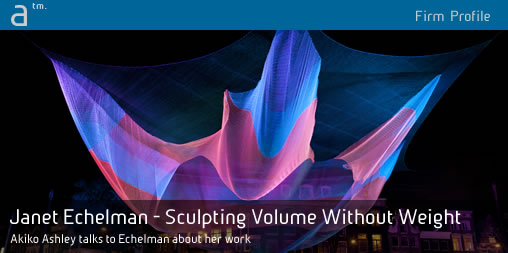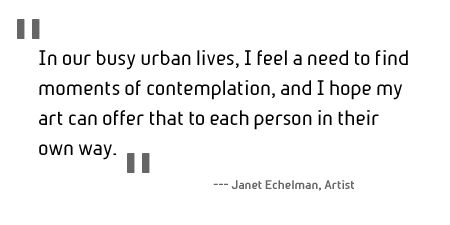At the end of September I decided to visit the Glow Festival held in Santa Monica, California. Glow is a festival of original art commissions created with lights re-imagining Santa Monica Beach. I took a walk down the boardwalk to explore these works by the hotel Casa Del Mar. I immediately noticed an organic shape taking form in the distance. You could see the web of a complex sculpture filling the sky transforming the beach into a work of art. It reminded me of something I saw in the cosmos, a beautiful nebula giving birth to new stars. (title graphic: “1.26” installation by Janet Echelman, seen in Amsterdam. photo by Janus vanden Eijnden. All rights reserved)
This is the work of Janet Echelman. I couldn’t look away, it was like being in a trance seeing something different every time you looked at it, the environment changed as the light changed. It was mind blowing. I wanted to get to know more about Janet and her work so I asked to interview her. Janet’s work is something you have to see in person, words can’t fully convey the true experience, as Janet’s work is totally interactive. The appeal is universal. Artists, architects, creative people of all disciplines will appreciate how she incorporates nature into her work.
Janet Echelman was the “Keynote Artist” this year for the Glow Festival; she is known for her organic, living, breathable sculptures that reflect Mother Nature’s balance. If you have not seen Janet’s work you should know that Janet Echelman was named Architectural Digest’s 2012 Innovator for “changing the very essence of urban spaces”.
It was in India where she was on a Fulbright lectureship when she became inspired by a new approach to creating sculptures, a way to create volumetric form without heavy solid materials, from fishing nets to water particles, combining ancient ideas with cutting edge technology to create sculptures that fill spaces the size of buildings. The amazing aerial piece she created for Glow “The Space Between Us” with her customized sculptured nets with corresponding landscaping sand below, creating a negative corresponding form, provide the ultimate viewing platform of the sky above. Let’s now get to know Janet Echelman and her work…
The Interview
AA (Akiko Ashley) : Can you tell me a little bit about yourself and your firm…and the collaboration of your team? What inspires you when you’re commissioned to do a piece?
JE (Janet Echelman): I’m moved by the responses that people share when experiencing my artwork. I hope my art creates an invitation to listen to our inner selves, and to connect us to one another in a public space. In that way, I hope my art can be a transformative element. In our busy urban lives, I feel a need to find moments of contemplation, and I hope my art can offer that to each person in their own way.
Each commission is closely tied to its location and context and I search for inspiration locally. For the San Francisco International Airport, I was asked to create a “zone of Recompose” for travelers after they go through security. I find calm in nature, and since airports seems to be completely devoid of nature, I wanted to bring it in. For Every Beating Heart Second we did this by cutting three round skylights into the ceiling and suspending delicate layers of translucent colored netting to create three volumetric forms. During the day, sun streams through the skylights to cast real shadows that interplay with fictional shadows we embedded in the floor. At night, a program of shifting colored lighting makes the sculpture glow as computer-mechanized airflow animates the sculpture to suggest wind and the presence of nature within Terminal 2. Visually, the sculpture evokes the contours and colors of cloud formations over the Bay and hints at the silhouette of the Golden Gate Bridge. (see image 01)

01 – Janet Echelman’s installation “Every Beating Heart Second” in the San Francisco Airport Terminal (photo by Bruce Damonte, All rights reserved).
I’ve been getting feedback that the sculpture is working, in terms of getting people to stop and look up, and slow down for a moment and contemplate phenomena. And I hear that total strangers have started conversations about the work.
AA: You began as a painter and moved into sculpture. Can you describe the transition and the challenges of working in a new medium?
JE: I started out as painter and moved into creating large public art installations and sculptures–from a very personal medium to one that has to infuse with the space and culture of where it is installed. The idea of creating a gesture is still very much a part of my work. But instead of creating a gesture with paint on a canvas, now I’m making an urban gesture with my sculpture–at the scale of the city.
Working on such a scale meant that I could no longer do everything myself. To create these sculptures, I work with colleagues in my studio, and a brilliant external team of aeronautical and mechanical engineers, lighting designers, computer scientists, architects, and industrial and hand-craft fabricators. We also need to collaborate with government officials, city planners, and engineering review boards to obtain permits to install our sculptures in cities.
I see public sculpture as a team sport. Being able to work with so many talented individuals expands the language with which I can speak as an artist. I am always learning from them, and together we create something greater than the sum of its parts.
I’ve had to find new kinds of fibers to meet the demands of Mother Nature. I’m now using a variety of high-tech fibers–some that are 15 times stronger than steel, and some that are colorfast and can withstand extreme exposure to ultra-violet light, high temperatures, pollution, and even chemical reactions–all while remaining strong and ultra lightweight. We select different fiber types depending on the harshness of the climate for each sculpture.
AA: Where do you find inspiration?
JE: I look all around me. I often look at the forms of living organisms, and also weather patterns. I am interested in the paths created by fluid dynamics–looking at nature with the help of science.
AA: Can you tell me about the 1.26 piece and how it takes on a new life in different locations?
JE: I’ve been working on a series for three years titled 1.26 that started in 2010, when I was commissioned to create a sculpture for the Biennial of the Americas in Denver, Colorado. I had been following the tragic earthquake that had just occurred in Chile, and I came across an article by a NASA scientist that measured the effects of the earthquake on the entire planet. I was surprised to learn the earthquake shortened the length of the day by speeding up the earth’s rotation by 1.26 micro-seconds. This became the catalyst for the artwork. I then looked at tsunami wave-height data to create a three-dimensional model of the tsunami’s amplitude rippling across the ocean, which inspired my textile form. The result was my sculpture 1.26, referring to the microseconds by which the day was shortened when the earthquake redistributed the earth’s mass.
1.26 became a travelling piece that has debuted on three continents. After North America, it traveled to Australia in 2011, suspended from Sydney Town Hall over its busiest street, and in Europe in 2012-2013, suspended from the Amsterdam City Hall and Opera House over the river. In each location, it takes on new meaning as it integrates within the fabric of the existing urban architecture.

02 – Echelman’s work “1.26” was inspired by a NASA scientist’s observation that the day was shortened by 1.26 microseconds on the day of the major Chilean earthquake in 2010. The piece traveled to three different continents. Here it is in Denver. (photo by Janet Echelman. All rights reserved).
Because 1.26 is made entirely of soft materials, it is very lightweight and can attach to existing architecture without extra reinforcement. Its soft surfaces are animated by the wind, and its fluidly moving form contrasts with the rigid surfaces of the surrounding urban architecture. At night, colored lighting transforms the work into a floating, luminous form while darkness conceals the support cables.
Developing a different color palette for each installation allows me to express a desired mood and content. For 1.26 Amsterdam, I experimented with using color opposites to neutralize the color of the twine to create an alternate mood, almost washing out the apparent color. I was thrilled with the dream-like, ephemeral quality this gave the sculpture, and its reflections in the undulating water below. (see image 02)
next page: What tools are used? (Interview and many more images continued…)





Reader Comments
http://t.co/efPIbLCIfZ — #echelman and her work discussed and viewed at @architosh
http://t.co/efPIbLCIfZ — #echelman and her work discussed and viewed at @architosh
http://t.co/efPIbLCIfZ — #echelman and her work discussed and viewed at @architosh
RT @architosh: http://t.co/kIyvCuYHq7 — #echelman and her work discussed and viewed at @architosh
RT @architosh: http://t.co/kIyvCuYHq7 — #echelman and her work discussed and viewed at @architosh
Comments are closed.